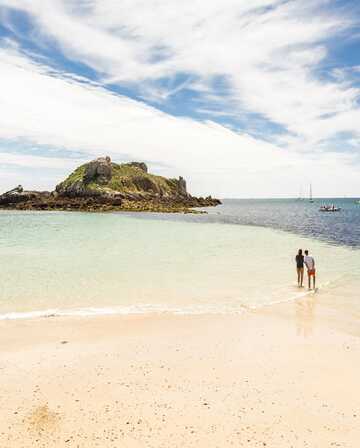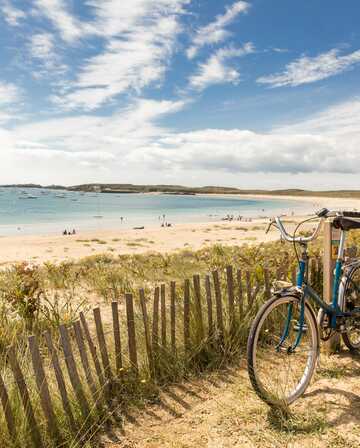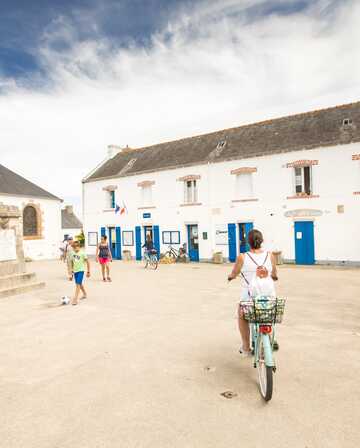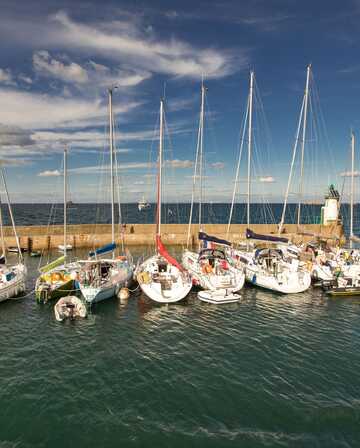The Morbihan island of Houat
5 km long and 1.5 km wide, the island of Houat off the coast of Quiberon is located in the south of Morbihan. You'll love it from the moment you arrive at Saint-Gildas, a small fishing port with colorful boats and piled-up traps. Houat is a peaceful, picturesque destination, ideal for a day's stopover or a short break.
How to get to Houat
Take a day trip to one of the wildest islands in southern Brittany. The island can be reached by boat from a number of ports in Morbihan, including Quiberon (one-way or round-trip all year round, 40-minute crossing), as well as from Locmariaquer, La Trinité-sur-Mer, Vannes and Port-Navalo in season. The crossing takes around 45 minutes to 1 hour, depending on the port of departure. It's advisable to book your tickets in advance, especially in high season.
Reservations can be made online or in our reception offices. Don't hesitate to contact us for more information: shipping company, pier, parking... You can also book a sea trip with a skipper to take to the open sea and discover the island in a different way.
Don't hesitate to consult the guide to sustainable mobility produced by the Association des îles du Ponant, to help you organize your stay on Houat on foot or by bike.
You can also download the"Houat et Hoedic, découverte du patrimoine des îles sœurs" mobile application. This immersive, accessible experience lets you discover the landscapes, history and culture of each island through geolocated points of interest, while raising awareness of heritage preservation. Application downloadable on Google Play or theApp Store.
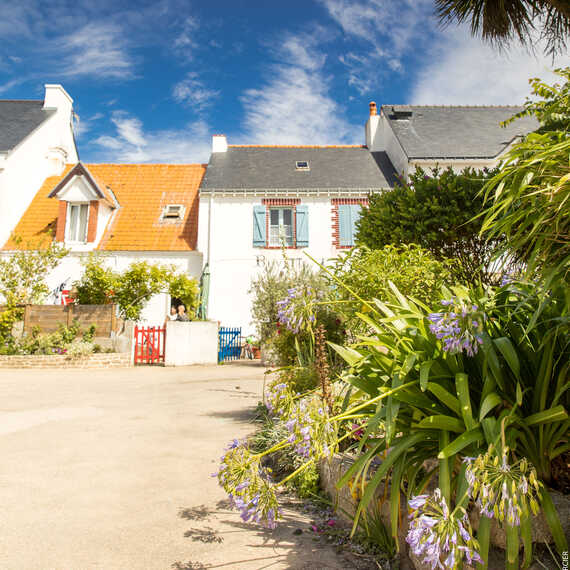
➔ 3 km long and 1.5km wide
➔ 288 hectares
➔ 17 km of coastal trails
Cross the typical Breton village and eat seafood in one of the island's restaurants.
Then, take the coastal path and walk along breathtaking landscapes in the heart of an exceptional nature.
Finally, relax on the large beach of Trearc'h Er Goured and enjoy its fine sand and turquoise waters.

- Coastal path
A hiking trail circles the island, offering panoramic views of the Atlantic Ocean, cliffs and beaches. The complete circuit of the island is around 14 km long and can be completed in 3 to 4 hours. The trail is relatively easy and accessible to all levels of walker. It is particularly enjoyable in spring and summer, when the flora is in full bloom.
- Port de Saint-Gildas
The small port of Saint-Gildas is a picturesque place where fishing boats and pleasure craft moor. Here you can often see local fishermen unloading their catch. The port is also a departure point for boat trips to neighbouring islands such as Hoedic.

- The village of Houat
Pass through the typical Breton village and touch the colourful hollyhocks. Stroll along the granite cliffs overlooking the ocean, contemplating the fragrant mauve moorland. There are a number of shops, restaurants and cafés. It's a great place to sample local specialities, including seafood in one of the island's restaurants.
- Treac'h er Goured Beach
Also known as the Grande Plage, this is the longest beach on the island, located in the south. It's famous for its fine sand and clear waters. It's the perfect place to relax, swim or take part in water sports such as kayaking or windsurfing. Tip: there is little shade on the island, so remember to bring hats or caps to protect yourself from the sun.
Don't miss the island ofHoedicits little sister, for a timeless break. During your stay, take the time to visit the Gulf of Morbihan on a guided cruise (departing from Locmariaquer, Auray, Vannes, Port Blanc...). Booking and information at the tourist office.
Tips for your visit
Preparation : Bring comfortable walking shoes, clothing suited to the climate (including a windproof jacket), and water, as resources on the island are limited.
Seasonality: The island is particularly pleasant to visit in spring and summer, but can be crowded in high season. If you prefer peace and quiet, opt for May or September.
Respect for the environment : Houat is an unspoilt island, so it's essential to respect nature by taking your garbage with you and not disturbing the local wildlife.
To preserve it, let's adopt the right gestures :
- On the beaches, keep your dog on a leash between April and August to protect nesting birds;
- At the beach, stay as close to the water as possible to avoid inadvertently crushing the nests of gravelots, which are well camouflaged in the sand at the top of the beach;
- Keep your distance: don't approach the birds, whether on land or at sea. If they fly away at your approach or utter alarm calls, they've been disturbed;
- Stay on marked footpaths and do not venture into the fragile and sensitive dunes;
- Don't throw anything away: on Houat, you can take your garbage with you.
- Visit the Eclosarium museum, which traces the history of the island, a Natura 2000 site, and invites you to discover the marine world that surrounds us.


